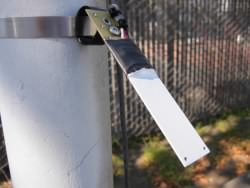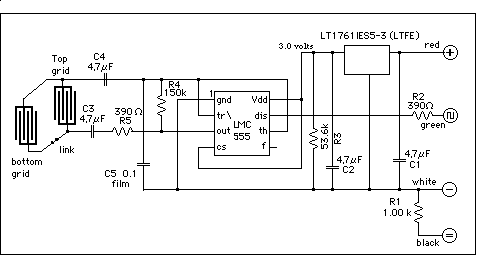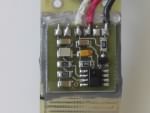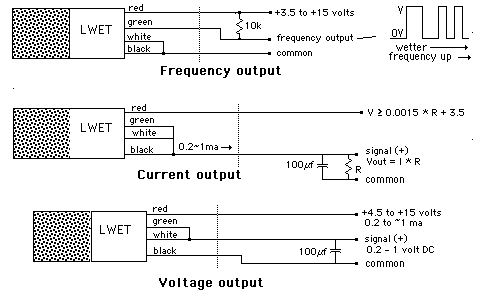LWET--Leaf
Wetness Sensor
For monitoring surface moisture deposition (dew, fog, rain)
in agriculture and industry
(c) 1999 EME
Systems
<products
index> <home>
 In
agriculture, warm, wet weather promotes fungus diseases and
moisture-loving insects. Direct surface wetness is pertinent,
because
it is within the leaf micro-environment or on other plant surface
that pathogens develop. Wetness data is usually reduced in
practice
to a yes or no form. For example, the Mills Tables are based on
the
hours that leaves remain wet while the temperatures are also warm.
Danger arises as a period of warm wet weather is prolonged, and
the
danger passes only after a certain number of dry hours have
elapsed.
Wetness measurements are also useful when the exact time of the
onset
of rainfall is of interest, for example, as part of control
systems
that automatically open and close greenhouse windows or schedule
irrigation. A rain gage is not as useful for this purpose, because
there is a delay before the rain gage accumulates enough water to
signal its first count . Humidity sensors are not so useful
either,
because there are many factors that determine precipitation.
Sensitive wetness measurements are also applicable to other areas
of
science and industry, such as the study of moisture in breath, or
of
corrosion on metals.
In
agriculture, warm, wet weather promotes fungus diseases and
moisture-loving insects. Direct surface wetness is pertinent,
because
it is within the leaf micro-environment or on other plant surface
that pathogens develop. Wetness data is usually reduced in
practice
to a yes or no form. For example, the Mills Tables are based on
the
hours that leaves remain wet while the temperatures are also warm.
Danger arises as a period of warm wet weather is prolonged, and
the
danger passes only after a certain number of dry hours have
elapsed.
Wetness measurements are also useful when the exact time of the
onset
of rainfall is of interest, for example, as part of control
systems
that automatically open and close greenhouse windows or schedule
irrigation. A rain gage is not as useful for this purpose, because
there is a delay before the rain gage accumulates enough water to
signal its first count . Humidity sensors are not so useful
either,
because there are many factors that determine precipitation.
Sensitive wetness measurements are also applicable to other areas
of
science and industry, such as the study of moisture in breath, or
of
corrosion on metals.
The LWET from EME Systems is an artificial leaf surface
constructed on a fiberglass circuit board. Moisture present on the
surface increases the frequency output from an integrated
oscillator
circuit. The LWET is distinguished from similar products by having
its AC excitation built in. It is not necessary to provide special
excitation from the data logger. Changes in frequency of the LWET
oscillator can be counted easily by our OWL2c data logger or other
micro-controller. Alternatively, the LWET has voltage and
current outputs directly
proportional to the level of wetness, so the sensor can also be
used
with data loggers that have analog inputs. The LWET has identical
sensing grids on top and bottom surfaces. The
grids can be painted with exterior latex paint to make the
response
more akin to a natural leaf.
Specifications:
- LWET Manual
- Supply Voltage: 5--15 VDC
less than 0.01% per Volt supply variation.
- Frequency output 50 hz dry @ infinite ohms
10 khz wet @ zero ohms
open collector square wave.
- Supply Current: 200±10µA dry to 1000µA wet
Can be used as analog output signal
- Voltage output, 0.2 to 1 volt.
- Operating Temperature: -0°C to +70°C
no meaningful signal below 0°C
- connection to data logger, 10 foot cable
4 wire flat telephone PVC jacket
red: + 5 to 15 volts DC
green: frequency signal, open collector, needs pull-up to +V,
50hz to 10khz
white: voltage output signal, 0.2 volts to 1 volt.
black: common, or analog current output.
- see SMX
documentation for resistance response.
- lifetime: 1 to 3 years (depends on contaminants)
- Top & bottom sensor grids are 1.625" x 0.625"
Overall size: 4.5" long x 0.75 wide x 0.031" thick, with
mounting holes for #6 screw.
Includes nylon loop for mounting. Pipe clamp not
provided.
- LWET ....................Base
Price..........$95
- LWET/P
................Painted...........no charge
Wiring the LWET to your data logger:
The figure below shows how to connect the sensor for digital
frequency output, current output and voltage output.
For frequency output, the resistor (10kohms, value not critical)
can pull
up to any voltage from 2.5 to 10 volts dc. The output signal
is
a square wave, and its frequency varies from 50 hz when the sensor
is
bone dry, up to 10000 hertz when the sensor is soaking wet. This
output can be measured using a COUNT function on the data logger.
The nest figure below shows how to connect the sensor for analog
output. The supply current is 200 (±10) microamps when the
sensor is bone dry and 1000 (±100) microamps when it is soaking
wet. The 1 kohm resistor converts the output to a voltage for
analog
meters. The analog current does not depend on the supply voltage,
so
long as the voltage across the sensor itself is greater than 4
volts.
The green "frequency signal" wire is not used in this
configuration.
And finally, the optional LWET/V has built-in circuitry to
provide
a voltage output instead of a frequency output. as shown in the
third diagram.
Notes on operation and installation
An excellent source for information about leaf wetness issues in
agriculture is to be found at:
http://www.nysaes.cornell.edu/pp/faculty/seem/magarey/leafwet/
• Placement of the sensor: The sensor should be placed in a
representative location. Sky and wind exposure are very important
in
dew deposition and in evaporation. Facing the sensor toward the
open
northern sky (in the northern hemisphere) will maximize the
catchment
of dew. Place the sensor at a 45° angle from the horizontal, so
that rain will not pool up. The mounting bracket facilitates the
mounting at the 45° angle. Since the LWET has active areas on
both the top and bottom surface, you have several options for
mounting the LWET on either a horizontal or a vertical support.
These
diagrams suggest some of these options.
• Painting the sensor: You can paint the surface of the
sensor with a high quality exterior grade flat white latex paint.
Painting will minimize the effect of contaminants, and it will
spread
out water droplets that fall on the surface. The consensus among
agricultural engineers is that this painting makes this type of
surface wetness detector better mimic the wetting and drying
characteristics of a leaf surface. You can order the sensor
prepainted from EME Systems.
• Maintenance: Clean the surface occasionally with a mild
detergent solution and rinse with clear water. Mild vinegar can
also
be used for cleaning. This is especially important if sulfur or
other
sprays have been applied.
•What is wet? The threshold level of electrical signal that
corresponds to "wet" must be determined empirically, by
observation.
A thin film of condensation on the bare sensor will increase the
frequency to 300 hertz, (or 0.3 volts for the LWET/V). Similarly
for
light rain. So 300 to 400 is a reasonable figure for determining a
yes/no answer to the question, "is it wet". Only when the sensor
is
immersed in a cup of water will the signal increase to the highest
level (10,000 Hz, 1 milliamp, 1 volt). Only immersion will
activate
both the top and the bottom grids. Rainwater is usually not very
conductive, so a value of 4000 hz (0.5 volt) will be typical in
heavy
rain. Light sprinkles of rain put drops here and there by chance,
and
detection only happens when one of those drops hits the LWET grid.
A
painted surface will spread out the drop and assure the response.
• Avoid exposure to agricultural sprays and exhaust fumes.
Contaminants deposited on the sensor surface may shift the
response
curve up, so that a given electrical response is caused by a
smaller
amount of moisture. Please wash the sensor frequently when it is
exposed to contaminated atmospheres. Painting the sensor can allay
the effect of contaminants. As the sensor ages, its zero (dry)
point
may shift up, due to contaminants. The software may need to adjust
for that shift of the baseline.
Circuit description:
The following is the schematic of the LWET, with
voltage, frequency and current output:

 The power supply voltage is regulated at 3 volts DC by the
micropower voltage regulator. The CMOS LMC555 timer operates in
its
direct feedback mode, with a square wave on the totem pole output
(pin 3) charging and discharging the 0.1 µf film capacitor
through the network of fixed resistors in series/parallel with the
conductive sensing grid. When the grid is dry, the 150k½ 1%
resistor
sets a minimum oscillator frequency of 50 hertz. When the grid is
wet, or short circuited, the 390½ 1% resistor in series with the
grid
limit the upper frequency to about 11 khz. The current through the
sensing grid is AC. The additional 4.7 uf capacitors in series
with
the grid assures that leakage currents do
not flow through the grid. The output frequency is transmitted to
the
logger from the open collector DIS output pin. Alternatively, the
supply current drawn by the circuit varies linearly with the
frequency, so the supply current is
proportional to wetness. For voltage output, the
supply current is converted to a voltage by the 1kohm 1%
resistor.
The power supply voltage is regulated at 3 volts DC by the
micropower voltage regulator. The CMOS LMC555 timer operates in
its
direct feedback mode, with a square wave on the totem pole output
(pin 3) charging and discharging the 0.1 µf film capacitor
through the network of fixed resistors in series/parallel with the
conductive sensing grid. When the grid is dry, the 150k½ 1%
resistor
sets a minimum oscillator frequency of 50 hertz. When the grid is
wet, or short circuited, the 390½ 1% resistor in series with the
grid
limit the upper frequency to about 11 khz. The current through the
sensing grid is AC. The additional 4.7 uf capacitors in series
with
the grid assures that leakage currents do
not flow through the grid. The output frequency is transmitted to
the
logger from the open collector DIS output pin. Alternatively, the
supply current drawn by the circuit varies linearly with the
frequency, so the supply current is
proportional to wetness. For voltage output, the
supply current is converted to a voltage by the 1kohm 1%
resistor.
<products
index>
<home>
<top>
 <mailto:info@emesystems.com>
<mailto:info@emesystems.com>
 In
agriculture, warm, wet weather promotes fungus diseases and
moisture-loving insects. Direct surface wetness is pertinent,
because
it is within the leaf micro-environment or on other plant surface
that pathogens develop. Wetness data is usually reduced in
practice
to a yes or no form. For example, the Mills Tables are based on
the
hours that leaves remain wet while the temperatures are also warm.
Danger arises as a period of warm wet weather is prolonged, and
the
danger passes only after a certain number of dry hours have
elapsed.
Wetness measurements are also useful when the exact time of the
onset
of rainfall is of interest, for example, as part of control
systems
that automatically open and close greenhouse windows or schedule
irrigation. A rain gage is not as useful for this purpose, because
there is a delay before the rain gage accumulates enough water to
signal its first count . Humidity sensors are not so useful
either,
because there are many factors that determine precipitation.
Sensitive wetness measurements are also applicable to other areas
of
science and industry, such as the study of moisture in breath, or
of
corrosion on metals.
In
agriculture, warm, wet weather promotes fungus diseases and
moisture-loving insects. Direct surface wetness is pertinent,
because
it is within the leaf micro-environment or on other plant surface
that pathogens develop. Wetness data is usually reduced in
practice
to a yes or no form. For example, the Mills Tables are based on
the
hours that leaves remain wet while the temperatures are also warm.
Danger arises as a period of warm wet weather is prolonged, and
the
danger passes only after a certain number of dry hours have
elapsed.
Wetness measurements are also useful when the exact time of the
onset
of rainfall is of interest, for example, as part of control
systems
that automatically open and close greenhouse windows or schedule
irrigation. A rain gage is not as useful for this purpose, because
there is a delay before the rain gage accumulates enough water to
signal its first count . Humidity sensors are not so useful
either,
because there are many factors that determine precipitation.
Sensitive wetness measurements are also applicable to other areas
of
science and industry, such as the study of moisture in breath, or
of
corrosion on metals.

 The power supply voltage is regulated at 3 volts DC by the
micropower voltage regulator. The CMOS LMC555 timer operates in
its
direct feedback mode, with a square wave on the totem pole output
(pin 3) charging and discharging the 0.1 µf film capacitor
through the network of fixed resistors in series/parallel with the
conductive sensing grid. When the grid is dry, the 150k½ 1%
resistor
sets a minimum oscillator frequency of 50 hertz. When the grid is
wet, or short circuited, the 390½ 1% resistor in series with the
grid
limit the upper frequency to about 11 khz. The current through the
sensing grid is AC. The additional 4.7 uf capacitors in series
with
the grid assures that leakage currents do
not flow through the grid. The output frequency is transmitted to
the
logger from the open collector DIS output pin. Alternatively, the
supply current drawn by the circuit varies linearly with the
frequency, so the supply current is
proportional to wetness. For voltage output, the
supply current is converted to a voltage by the 1kohm 1%
resistor.
The power supply voltage is regulated at 3 volts DC by the
micropower voltage regulator. The CMOS LMC555 timer operates in
its
direct feedback mode, with a square wave on the totem pole output
(pin 3) charging and discharging the 0.1 µf film capacitor
through the network of fixed resistors in series/parallel with the
conductive sensing grid. When the grid is dry, the 150k½ 1%
resistor
sets a minimum oscillator frequency of 50 hertz. When the grid is
wet, or short circuited, the 390½ 1% resistor in series with the
grid
limit the upper frequency to about 11 khz. The current through the
sensing grid is AC. The additional 4.7 uf capacitors in series
with
the grid assures that leakage currents do
not flow through the grid. The output frequency is transmitted to
the
logger from the open collector DIS output pin. Alternatively, the
supply current drawn by the circuit varies linearly with the
frequency, so the supply current is
proportional to wetness. For voltage output, the
supply current is converted to a voltage by the 1kohm 1%
resistor.